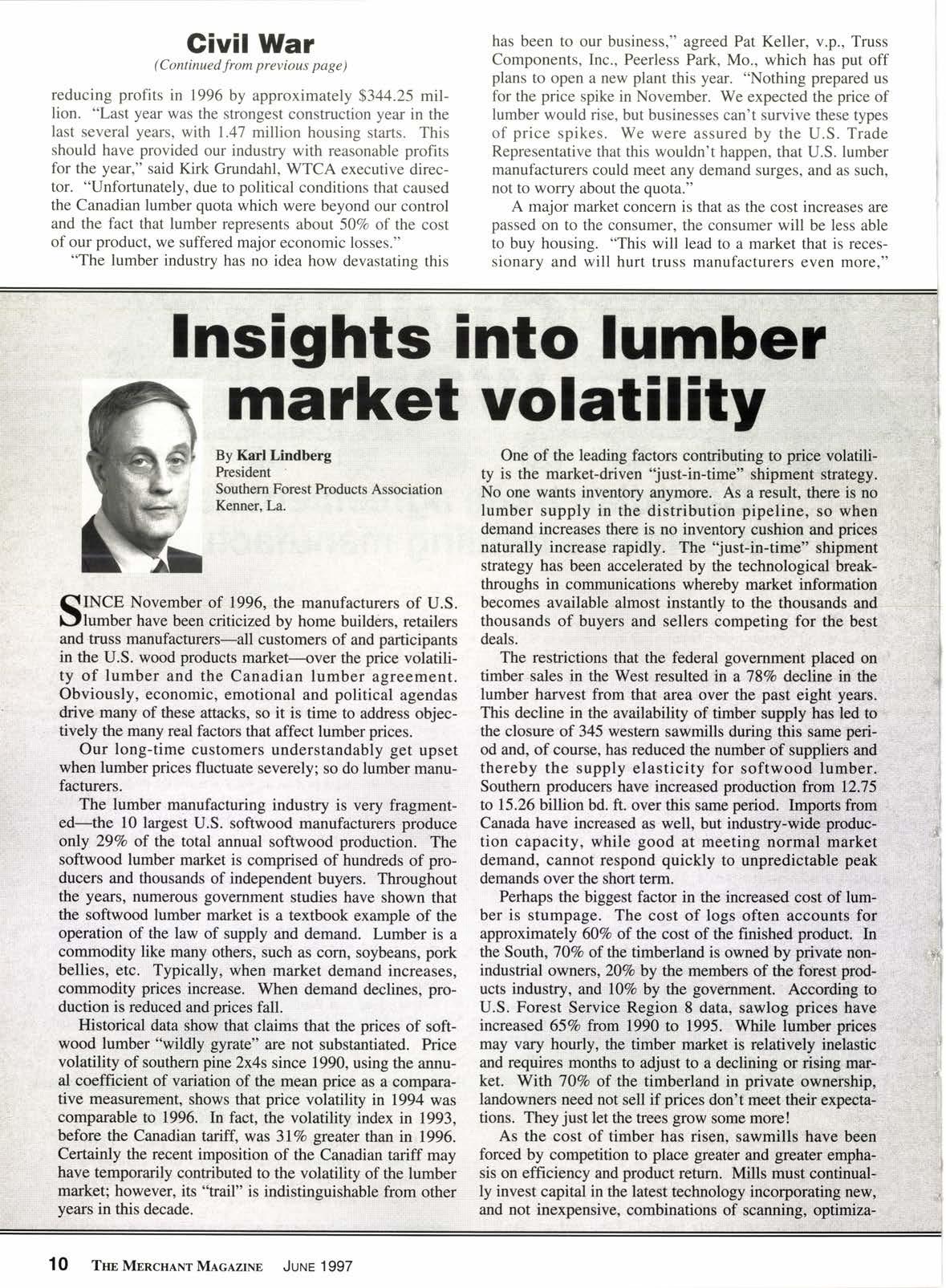
3 minute read
lnsights into lu ma volatilit
ByKarlLindberg i:ri"ri'' r i'ir i'ii']"l President : rr ,'l Southern Forest Products Association Kemer, La
QINCE November,::6f:r tr996, the manufacturers of U.S. Dlumber have been,rlCritiitfsd by home builders, retailers and truss manufacturgrsgll oustomers of and participants in the U.S. wo@ ctsrrmarket-over the price volatility of lumber and thro'Canadian lumber agreemenr. Obviously, economic, emotional and political agendas &iw many of these attack, so it is time to address objectirely the many real factors that affect lumber prices.
, Our long-time customers understandably get upset ,, ,,whea lumberprices fluctuate severely; so do lumber manu*
'.'. ' ,,,,,,',,.,,,:,.,:',,
:,1. ,': 1,I'11t lumber manufacturing industry is vety'l'ry**;t l: rr,,, ed*-dte 10 largest U.S. soft wood manufactufcis.:ttsdoee
.,.,.l',only 29Vo of the total annual softwood production. The softwood lumber market is comprised of hundreds of pro1''ducers and thousands of independent buyers" T,hryugfiolit , the years, numerous government studies have shown that tlw softwood lumber market is a textbook example of the oporation of the law of supply and demand. Lumber is a commodity like many otlrcrs, such as corn, soybeans, pork bellies, etc. Typically, when market demand increases, commodity prices increas*',1Vhen demand declines, production is reduced and prices fall.
Historical data show that claims that the prices of softwood lumhr "wildlyt.l: mrc:l,,me not substantiated. Price volatility of southern$ite,2x since 1990, using the annual coefficient of variation of the mean price as a comparative measurement, shows that price volatility in 1994 was comparable to 1996. In fact, the volatility index in 1993, ' before the Canadian lariff, was 3l%a grearter than in 196. ,, :,Certaialy the recent imposition of the Canadian qariff may ',:,r,,hav* temporarily contributed to the volatility of ,fte iumber market; however, its'trail" is indistinguishable from other :,.:..l,'Y-*Arq ia this decade :,
Keller explained.
Of course, there are other reasons for the price spikes besides the quota (see story below). One of the greatest is the lockup of federal timberlands, which has placed domestic producers at a disadvantage and continues to threaten the steady flow of supply.
Unfortunately, many retailers, contractors and builders are short-sighted. They all but ignore the environmental crisis, reasoning that ifthey're not the ones actually cutting the trees, it's not their fight.
Said one multi-state lumber dealer association executive who is mobilizing his members in the civil war over the trade pact: "We wanted a fight that was winnable."
Gary Donnelly, president, National Lumbr & BuiHing Material Dealers Association, Washington, D.C. :
"ln our opinion, the effect has been much higher lumber prices for U.$. consumers, greatly increased profits to U.S. producers, increased volatility in the lumber markets and a scarcity of some products. lf lumber dealers got together to raise prices, they would all go to jailfor violating the anti-lrusl laws of this country. Members of the Coalition for Fair Lumber lmports, using U.S. trade laws, have found a way to circumvent those laws."
Bobert H. Hunt, president, Western Wood Products Association, Portland, Or. :
'The major etfect on lhe lumber markel and prices in 1996 was demand and rumors, not the U.S.-Canadian softvvood trade agreement. This past year resulted in a near record for U.S. sottwood consumption at 50.53 billion M. fi. The record set'in 1987 was 50.56 billion ft. Our largest market-housing, was also up over 9%.
"Builder and dealer organizations claim the agreement has increased the volatility of lumber markets to record levels. However, a review of price trends in recent years does not support that conclusion. The price volatility in 1996 was lower than three years ago, when there was no agreement.
"Also, il should be pointed out that Canadian imporls hit an all-time high in 1996 under the agreement, with very little ol that volume affected by duties. So, at best, the agreement had only a minor impact on prices and nothing on volumes.
"As the 1996 agreement rumors are put to bed, the supply/demand outlook for '1997 is positive, with less volatility and good business for dealers "

Dr. Leonard M. Guss, president, Leonard Guss Associates Inc., Woodinville, Wa.:
"The eflect has been pretry much as expected. U.S, production in 1996 was up 5olo ov€r production in 1995, but still below production in 1994. Massive public timber withdrawals in the Pacific Northwest, and the heavy rate of cutting in the $outheast almost guarantee a lid on U.S. production volume, tado agreement or no trade agreement. However, the impact on prices is obvious, .Prices for slandard conslruction lumber items are al or near their historical highs. Far from discouraging Canadian imports, softwood lumber from Canada suryed into the U.S. lo take advantage of this price umbrella, reaching a new peak of 17.8 billion bd. ft. in 1996, from over'17 billion in'1995. Canadian lumber producers cheerfully paid the $50 or $1tD per MBF penalty for shipments over quota, and chortled all the way to lhe bank. Meanwhile, house conslruction prices \i,ent up for the U.S. consumer-as it was meant to do. The only impact of the trade agreement is more revenue for U.S. lumber mills."
H. Daniel Pincus, Hilton Head, S.C., home builder, and presi-
'The only people benefiting from the Canada-U.S. lumber agreement are the timber barons, The duty on lumber from Canada is essentially a tax 0n homeownership lhat is costing homebuyers billions of dollars a year."

